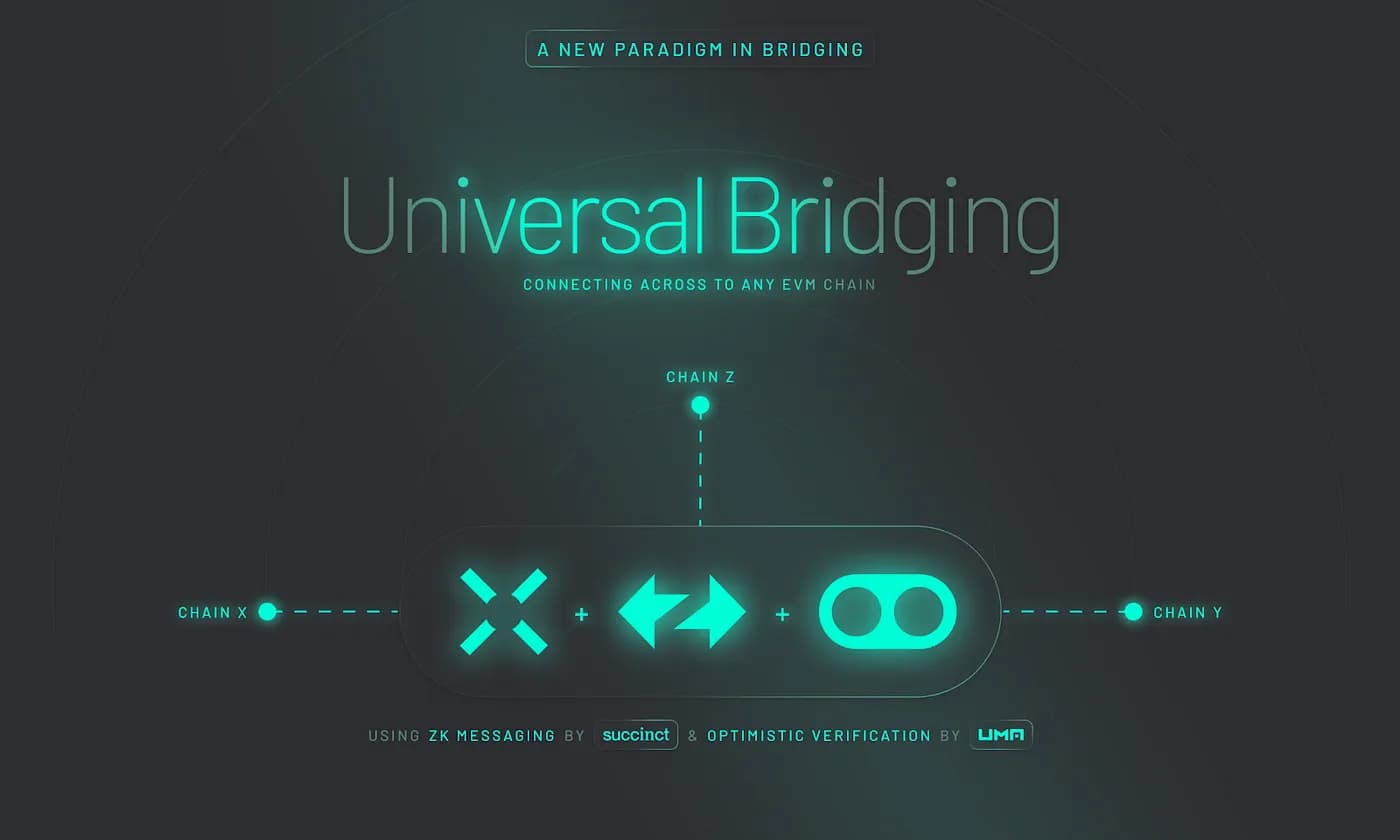Introduction
Bridging isn’t solved until it scales.
Across V4 is live, and it is built to bridge more chains, faster.
Until now, every new chain was a project. It was a rigorous process with long audit times and custom smart contracts for every new chain. With Across V4, expansion is no longer a blocker. It’s a feature.
We’ve completely re-architected the protocol to move faster than ever without compromising on speed, cost, security, or user experience. The result? A scalable, flexible, and lightning-fast bridge that gives users more options, relayers more freedom, and builders fewer reasons to hesitate.
And the most exciting part? It's all powered by intents and zero knowledge (ZK) proofs.
Let’s dive in.
Key Takeaways
Across V4 is live, unlocking faster support for new chains through a universal, scalable architecture powered by intents and zero-knowledge proofs.
Succinct’s zkVM (SP1) enables ZK proofs of Ethereum state, allowing any chain to verify messages via a single universal verifier. No custom adapters required.
Integrate once, scale everywhere. Across V4 works out of the box, giving developers instant access to more chains without additional audits, deployments, or complexity. Existing integrations need zero code changes.
Users benefit from more supported chains, faster availability of new assets, and seamless bridging experiences across the ecosystem.
Relayers gain flexibility with origin-chain repayment, open rebalancing strategies, and greater autonomy in capital allocation.
What Is Across V4?
Across V4 is a fundamental upgrade to how the Across Protocol works under the hood.
At a high level, it’s a shift from a central “hub-and-spoke” model to a lightweight, universal design. Instead of wiring in custom support for every chain, we’ve teamed up with Succinct to introduce a system powered by ZK proofs that verifies intent settlement across chains securely and universally.
What does that mean in plain English?
It means we can now add new chains in a matter of hours, not weeks. Any ERC-20 token can be bridged at the protocol level by default, as long as a relayer is willing to fill it. Relayers get to choose how they operate, giving them new ways to optimize and compete.
But most importantly, users get access to more routes, chains, and assets faster than ever.

Why V4 Matters (and Who It’s For)
Whether you're a user, builder, relayer, or chain team, V4 offers something that makes your life easier and your onchain experience better. Here's what that means:
Users get more supported chains, more bridge routes, and faster availability of new tokens.
Builders integrate Across once, and tap into a growing universe of L1s and L2s without waiting for audits or custom deployments.
Relayers are no longer bound to protocol-defined repayment flows. Repayments now happen on the origin chain, and you can rebalance however you want (via CEXs, other bridges, or your own systems).
Chains can integrate quickly and easily. If your ecosystem needs a bridge and there’s a clear user demand, Across can now launch support with almost zero friction.
V4 is designed to make bridging easier for everyone.

Key Shifts at a Glance
Across V4 introduces a set of foundational changes that unlock new speed, scale, and flexibility for the protocol. This quick comparison between V3 and V4 shows just how many core constraints have been lifted from Across' previous architecture.

Every structural limitation that slowed V3 has been eliminated in V4. Now, we're built to scale fast.
The ZK-Powered Expansion Engine
The secret to V4’s scalability is ZK tech, powered by Succinct.
In V3, adding a new chain meant building adapters, writing custom logic, and submitting new smart contracts for audit. Even chains within the same ecosystem (e.g., OP Stack or Arbitrum Orbit) required different configurations.
Now? One universal deployment. One set of contracts. One proof system.
Succinct’s zkVM, SP1, makes this possible. It generates ZK proofs that confirm relayer repayment bundles (already verified by UMA’s optimistic oracle) are stored on Ethereum. These proofs can be verified by any destination chain using a universal verifier contract. The result: secure, trustless transmission of validated messages across chains, enabling Across Protocol to access more chains, faster.
We’ve already proven this approach in production. Across’ deployment on BNB Smart Chain was the first implementation of V4’s architecture.
When you combine intents and ZK proofs, magic happens.

A Quick Tour of the New Architecture
Across V4 introduces a completely reimagined flow for intent settlement, designed to be faster, more flexible, and easier to scale. Instead of relying on chain-specific integrations, we now use zero-knowledge proofs and a universal verifier system to bridge user intents across any supported chain.
Here’s how V4 works under the hood.
1. Anchor the Intent on Ethereum
When a user initiates a bridge transfer (i.e., their intent), relayers front the liquidity on the destination chain. These fills are batched together into a repayment bundle. This bundle is then submitted to UMA’s optimistic oracle on Ethereum mainnet, which acts as the source of truth. If no one disputes the validity of the bundle during the challenge window, it's considered final and valid.
The hash of the bundle is then written to a designated storage slot in the HubPoolStore contract on Ethereum. This storage event emits a StoredCallData event that later becomes the anchor for ZK verification along with the data stored in the HubPoolStore contract.

2. Prove It with ZK
After the repayment bundle is stored on Ethereum, a component called the Finalizer indexes the chain and listens for the StoredCallData event. When it detects it, the Finalizer triggers the ZK API, which then triggers the generation of a ZK proof using Succinct’s SP1 zkVM.
The ZK API is a stateful service that manages the entire proof lifecycle, using Redis to track requests through four statuses (::WaitingForFinality, ::Generating, ::Success, or ::Errored).
The API gathers all the necessary data:
Finalized beacon headers.
Collective signature from Ethereum's sync committee (a group of 512 validators that attest to block finality).
Merkle proof demonstrating that the specific storage slot in the
HubPoolStorecontains the message hash from the event.
This proof confirms that the repayment data was indeed recorded on Ethereum. The proof is computed and passed along for crosschain verification only after Ethereum finality is achieved.

3. Verify and Execute on the Destination Chain
The completed ZK proof is submitted to the Sp1Helios verifier contract on the destination chain. This contract checks the validity of the proof and stores the repayment bundle root hash. Then, a follow-up call is made to the UniversalSpokePool on the destination chain, which queries Sp1Helios to confirm the hash. Once the hash is confirmed, the UniversalSpokePool processes individual relayer refunds via separate calls to functions like .executeRelayerRefundLeaf().
Importantly, the actual repayment to relayers happens on the origin chain of the user’s intent (or deposit).

What this Means for Developers and Integrators
For developers and integrators building with Across, the V4 upgrade is designed to be integrated seamlessly while providing a more powerful and scalable settlement backend.
Here’s what this means for you:
No Changes to Your Integration: The Across API and App-SDK are already V4-activated. Your current implementation for initiating user transfers will continue to work without any changes.
New Onchain Event to Watch: For those who index onchain data, the biggest change is the new settlement trigger.
Before V4: You had to monitor events on chain-specific bridge adapters.
After V4: The deposit/status API is still the best way to track your deposits. However for Relayers, the single source of truth is the
StoredCallDataevent from theHubPoolStorecontract on Ethereum. This event signifies that a crosschain message is officially queued for ZK proofing and final settlement.
This new architecture is what allows Across to expand to more chains faster, giving your dApp and its users wider access to the booming crosschain ecosystem.
Integrate Once, Scale Everywhere
Across V4 stands out as one of the most pragmatic applications of ZK technology, V4 fundamentally redefines the challenge of crosschain expansion.
No more slow, bespoke integrations with third-party bridges, each requiring its own adapters, audits, and trust assumptions. V4 introduces a new paradigm: onboarding a chain is no longer a multi-month R&D project, but rather a standardized deployment of our universal verifier contracts.
As a developer, Across V4 is your ultimate force multiplier. By integrating with Across once, you unlock access to a growing list of supported chains without ever lifting a finger when new ones are added. You enjoy the benefits of fast bridging, low fees, and secure settlement, all powered by our battle-tested infrastructure and ZK verification.
We handle the complexity of proving Ethereum's state anywhere, so you can focus on what you do best: building incredible applications for your users, wherever they are.
This isn't just an upgrade. It's an open invitation to build on infrastructure designed for explosive, crosschain growth.
What’s Next?
Across V4 is already live in production. In fact, it successfully powers our BNB Smart Chain bridge, which we deployed a month ago.
But we’re just getting started, and more chains are coming.
The upgrade is also the foundation for what’s next on the Across roadmap:
Across Prime and deeper relayer incentives (learn more).
New routing strategies to optimize for speed, cost, and liquidity.
Better UX and token support for crosschain users.
The goal is simple: Make Across the fastest, most reliable, and easiest-to-integrate bridge in web3.
And now, we’ve got the architecture to do it.
Your Gateway to the Crosschain Future
Whether you're bridging assets, building dApps, or running a relayer, Across V4 opens the door to more chains, more users, and more possibilities.
Ready to get started?
More Chains. Faster.





